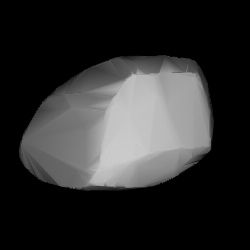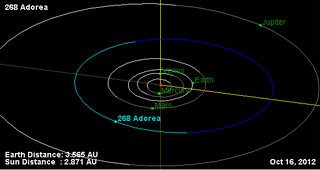
Dike is a quite large and dark main-belt asteroid. Dike was discovered by Alphonse Borrelly on May 28, 1868. It was his first asteroid discovery. This object is named after Dike, the Greek goddess of moral justice. Among the first hundred numbered minor planets, 99 Dike was considered anomalously faint for over a century. However, this was later found to be untrue.

Sirona is a somewhat large and bright-colored main-belt asteroid that was discovered by the German-American astronomer C. H. F. Peters on September 8, 1871, and named after Sirona, the Celtic goddess of healing.

Lachesis is a large main-belt asteroid. It was discovered by French astronomer Alphonse Borrelly on April 10, 1872, and independently by German-American astronomer Christian Heinrich Friedrich Peters on April 11, 1872, then named after Lachesis, one of the Moirai, or Fates, in Greek mythology. A Lachesean occultation of a star occurred in 1999 and was confirmed visually by five observers and once photoelectrically, with the chords yielding an estimated elliptical cross-section of 184 × 144 km.

Eurykleia is a fairly large main belt asteroid. It was discovered by the Austrian astronomer Johann Palisa on April 19, 1879, and named after Euryclea, the wet-nurse of Odysseus in The Odyssey.

Hedda is a sizeable Main belt asteroid. It is a C-type asteroid, meaning it is primitive in composition and dark in colour. This asteroid was discovered by Johann Palisa on October 17, 1879, in Pola and was named after Hedwig Winnecke, wife of astronomer Friedrich A. T. Winnecke.

Carolina is a sizeable Main belt asteroid. It was discovered by Austrian astronomer Johann Palisa on 28 November 1883 in Vienna, and was named after Caroline Island, now part of Kiribati in the Pacific Ocean. This asteroid is orbiting the Sun at a distance of 2.88 AU with a period of 4.89 yr and an eccentricity (ovalness) of 0.06. The orbital plane is tilted at an angle of 9.0° to the plane of the ecliptic.

Adrastea is a main belt asteroid. It was discovered by Johann Palisa on 18 August 1884 in Vienna, and was named after the Greek nymph Adrasteia. This asteroid is orbiting the Sun at a distance of 2.97 AU with a period of 5.11 years and an eccentricity (ovalness) of 0.23. The orbital plane is tilted at an angle of 6.17° to the plane of the ecliptic.

268 Adorea is a very large main belt asteroid, about 140 km in width. It was discovered by A. Borrelly on 8 June 1887 in Marseilles. This asteroid is a member of the Themis family and is classified as a primitive carbonaceous F-type/C-type asteroid. It is orbiting the Sun at a distance of 3.09 AU with an orbital eccentricity (ovalness) of 0.14 and a period of 5.44 yr. The orbital plane is tilted at an angle of 2.44° to the plane of the ecliptic.

Nenetta is an A-type asteroid with a diameter of 38 km. It was discovered by Auguste Charlois on 10 March 1890 in Nice, France. The asteroid is orbiting the Sun at a distance of 2.87 AU with an eccentricity (ovalness) of 0.204 and an orbital period of 4.87 yr. The orbital plane is inclined at an angle of 6.7° to the plane of the ecliptic.

Etheridgea is a large main belt asteroid. It was discovered by Auguste Charlois on 1 April 1892 in Nice. The meaning of the name is unknown. This asteroid is orbiting the Sun at a distance of 3.02 AU with a period of 5.26 years and an eccentricity (ovalness) of 0.10. The orbital plane is tilted at an angle of 6.05° to the plane of the ecliptic.

May is a large Main belt asteroid. It was discovered by Auguste Charlois on 28 November 1892 in Nice, and was named for the German author Karl May. This asteroid is orbiting the Sun at a distance of 2.97 AU with a period of 5.12 years and an eccentricity (ovalness) of 0.067. The orbital plane is inclined at an angle of 9.7° to the plane of the ecliptic. During its orbit, this asteroid has made close approaches to the dwarf planet Ceres. For example, in September 1984 the two were separated by 6.3 Gm (0.042 AU).

Delia is a large Main belt asteroid. It was discovered by the French astronomer Auguste Charlois on 30 November 1894 in Nice. "Delia" is an epithet for the ancient Greco-Roman Moon goddess Artemis, for her birthplace at Delos. This asteroid is orbiting the Sun at a distance of 2.79 AU with an orbital eccentricity (ovalness) of 0.085 and a period of 4.64 yr. The orbital plane is tilted at an angle of 3.35° to the plane of the ecliptic.

402 Chloë is a large main-belt asteroid. It was discovered by French astronomer Auguste Charlois on 21 March 1895 from Nice. This asteroid is orbiting the Sun at a distance of 2.56 AU with a period of 4.09 years and an eccentricity of 0.11. The orbital plane is inclined at an angle of 11.8° to the plane of the ecliptic.
Stereoskopia is a large, outer main-belt asteroid orbiting the Sun. It was discovered on 28 May 1905 from Heidelberg by German astronomer Paul Götz. The discovery was made from photographic plates with the use of a stereo-comparator that had been provided by Carl Pulfrich, a German physicist at the Carl Zeiss Company. The asteroid name is a reference to this device.

699 Hela is a Mars crossing asteroid. It was discovered on 5 June 1910 at Heidelberg by German astronomer Joseph Helffrich, and may have been named after Hel, the Norse ruler of the underworld. This asteroid is orbiting the Sun at a distance of 2.61 AU with a period of 4.22 years and an eccentricity of 0.41. The orbital plane is inclined at an angle of 15.3° to the plane of the ecliptic.
738 Alagasta is a main belt asteroid. It was discovered from Heidelberg on 7 January 1913 by German astronomer Franz Kaiser. The asteroid was named in honor of Gau-Algesheim, previously Alaghastesheim, which is the home city of the discoverer's family. This body is orbiting at a distance of 3.04 AU with a period of 5.29 years and an eccentricity of 0.055. The orbital plane is inclined at an angle of 3.53° to the plane of the ecliptic.
742 Edisona is a minor planet, specifically an asteroid orbiting in the asteroid belt that was discovered by German astronomer Franz Kaiser on February 23, 1913. It was named for inventor Thomas Edison. This asteroid is orbiting 3.01 AU with a period of 5.22 years and an eccentricity of 0.119. The orbital plane is inclined at an angle of 11.2° to the plane of the ecliptic. This is a member of the dynamic Eos family of asteroids that most likely formed as the result of a collisional breakup of a parent body.
774 Armor is a minor planet orbiting in the main belt. It was discovered on December 13, 1913, in Paris by French astronomer Charles le Morvan and was named after the Celtic region of Armorica. The asteroid is orbiting at a distance of 3.05 AU with a period of 5.32 yr and an eccentricity of 0.169. The orbital plane is inclined by an angle of 5.56° to the plane of the ecliptic.
780 Armenia is a minor planet in the asteroid belt orbiting the Sun. It is named after the Kingdom of Armenia, now Armenia. This object is orbiting at a distance of 3.11 AU with an eccentricity of 0.097 and a period of 5.50 yr. The orbital plane is inclined at an angle of 19.1° to the plane of rotation. This asteroid spans a girth of ~94 km. The long rotation period of this asteroid necessitated light curve data from more than one latitude. The overlapping data provided a solution with a period of 19.891±0.002 h and a brightness amplitude of 0.18±0.03 in magnitude.
1851 Lacroute, provisional designation 1950 VA, is an asteroid from the outer region of the asteroid belt, approximately 17 kilometers in diameter.














